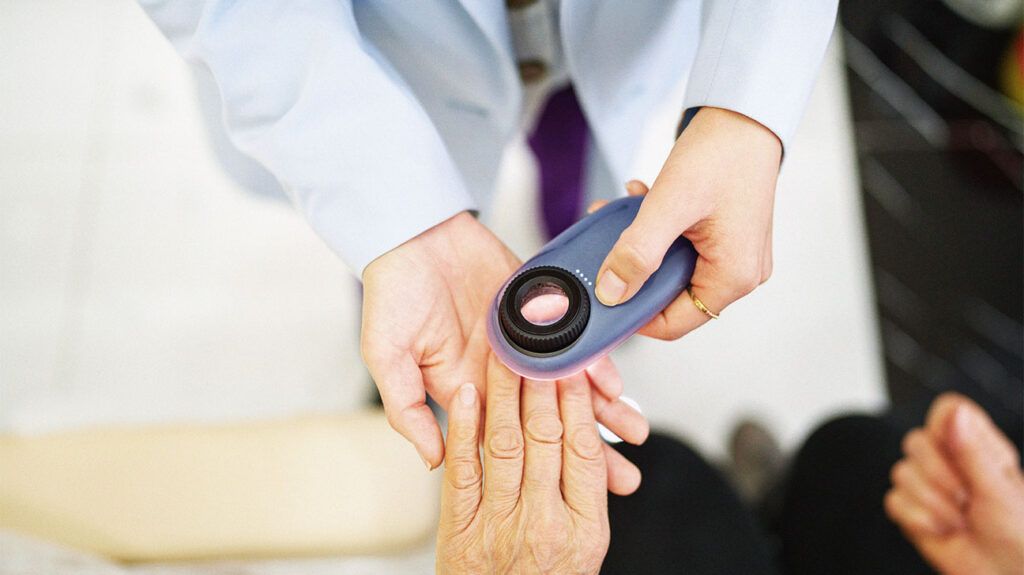A black line in the nail may be simply a color variation, but it can also result from an injury. Other possible causes include the use of certain drugs and various health conditions, including HIV and cancer.
When a person has black or dark stripes running down their nails, the explanations can range from a natural occurrence to severe, such as melanoma.
A person should not ignore changes to their nails, especially if they are painful, bleeding, and occur without explanation.
This article discusses the cause of black lines on the nail. It also goes over other symptoms and treatments.

Most commonly, dark stripes down a person’s nails are due to a symptom known as linear melanonychia. According to DermNet, these stripes more commonly occur in people with darker skin tones. They state that nearly all Afro-Caribbean people develop these dark pigmentations on their nails by the age of 50.
Linear melanonychia is considered a natural fingernail color variation. The condition occurs when pigments in the nail, known as melanocytes, make excess pigment. This causes the nail beds to darken.
Less common causes of nail melanonychia exist. These include:
- taking certain medications, such as chemotherapy drugs, beta-blockers, anti-malarial drugs, or the medication azidothymidine
- HIV
- Laugier-Hunziker syndrome
- Lupus
- Peutz-Jeghers syndrome
- scleroderma
Another cause of black lines on the nails is a splinter hemorrhage, which occurs when blood vessels under the fingernail are damaged, often due to injuries, such as hitting.
More seriously, a black line or lines on the nails can indicate the presence of melanoma, a dangerous form of skin cancer.
Melanoma under a fingernail is
However, ALM is a somewhat rare type of melanoma. It accounts
Typically, healthy fingernails will have small vertical ridges in them, are curved downward from the nail, and do not crack or break easily. However, there are times when a person may experience black lines on the nail.
Linear melanonychia
When a person has linear melanonychia, they may see dark stripes running down the nails. They may have color variations that range from black to deep brown and gray. Most individuals who experience this discoloration experience it on more than one nail.
Subungual melanoma
When a person has subungual melanoma, they will usually notice a stripe on one fingernail only. Often, they cannot link the stripe’s appearance back to an injury.
Typically, a black stripe from subungual melanoma will darken or widen with time. Sometimes, the nail will be painful or bleed.
The pigmentation may also extend to the area where the fingernail meets the cuticle. This is
Splinter hemorrhage
Splinter hemorrhages appear as small black or deep-red lines and are caused by injuries to the small blood vessels under the nail beds. They usually heal on their own within a few days.
If a person has multiple splinter hemorrhages across several different nails, it could indicate an underlying condition.
The diagnostic process for dark lines under the fingernails usually starts with a person’s medical history.
Questions a healthcare professional may ask include:
- How long have the lines been present?
- When were you first aware of the lines?
- Have you noticed any recent changes to the lines?
- Have you had a trauma to the nails that may have caused these changes?
A doctor will also ask about medications. If a person has a history of taking blood thinners, such as warfarin or aspirin, this could explain splinter hemorrhages.
Sometimes a healthcare professional will take a biopsy or sample of the nail area. They will send this biopsy to a pathologist, who can identify if any cancerous cells might be present.
Most causes of black lines on the nail do not require treatment. Melanoma is an exception. A healthcare professional will
A surgeon can perform a skin graft over the fingernail to improve the finger’s appearance postsurgery.
If the melanoma had spread to the bone, a doctor might recommend amputating the finger to stop the melanoma from spreading further. However, according to current guidance, this is only done if there is no other option.
It is especially important to contact a healthcare professional if a person has a nail that is bleeding and painful or has changed without a known cause.
A person should contact their healthcare professional if they notice changes to the quality of the nail itself, such as thinning, cracking, or differences in the shape.
Most black lines on the fingernails and toenails are not cause for concern. These lines are fairly common among people with darker skin tones.
However, they can be a sign of subungual melanoma. In these cases, the earlier the condition is diagnosed, the better the outlook.
A person should speak with a healthcare professional about any changes to the nail that cannot be linked back to an injury.
